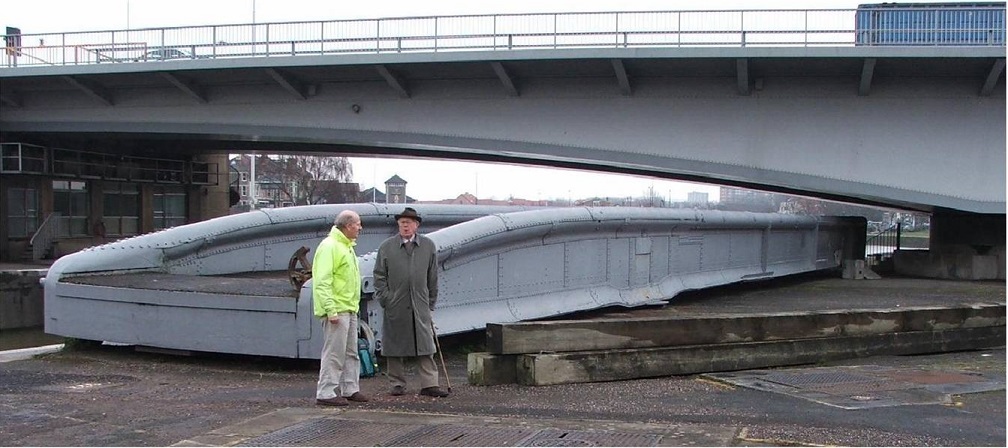Brunel Swivel Bridge Project

David Neale (former City Docks Engineer, who discovered the true history of the bridge and saved it from being scrapped) and Professor Roy Severn
Progress before 2013
- August 2012: As with projects in the past, Geoff Wallis (former Director of Dorothea Resorations) developed a sensible scheme (which would include sliding the bridge to a nearby location for repair), carry out some of the work voluntarily, raise funds from the usual sources, and progress the restoration work in phases.
- July 2012: Site visit to the bridge for BIAS and AIBT
- April 2012: Meeting with the Council
- 12 Apr 2012: Presentation about the Bridge to the Bristol Industrial Society (BIAS) by David Neale, where we learnt of a failed lottery bid mainly due to expensive and controversial proposals to dismember the bridge, remove it to a repair site, possibly on the south quayside of Cumberland Basin, and to return and reassemble repaired components. Afterwards it was decided that the combined efforts of the Brunel Swivel Bridge Group, BIAS, and Avon Industrial Buildings Trust (AIBT) could move this forward independent of the Council, but with their agreement and co-operation.
- 11th January 2012: Brunel Swivel Bridge Consultation Event in the Create Centre
- 23 Nov 2011: A meeting arranged to assist in the formulation of Bristol City Council's Stage 2 Bid to the Heritage Lottery Fund for re-commissioning the Brunel Swivel Bridge.
- January 2010: Jon Usher, Project Officer, Infrastructure, for
Bristol's Cycling City Team asks for quotations / proposals for the
following in respect of the Brunel Swivel Bridge at the entrance to the
Bristol City Docks:
- Jacking up the bridge for inspection and refurbishment;
- Carrying out the inspection and producing engineering feasibility
reports and estimates for
(a) Restoring the bridge as a static monument and
(b) Re-commissioning the bridge.
-
Brunel Bridge plan dropped
29 December 08: Plans for a Festival Way cycling and walking route from Hotwells to Ashton Court and on to Nailsea were intended to bring back into use Brunel's 160 year
old swing bridge that crossed the entrance lock at the western end of the Cumberland Basin. The bridge ceased to be used in 1968 after the new flyover system was built
but remains in situ in the 'open' (to navigation) position in the shadow of the high level swing bridge and flyover system.
But a press release from Sustrans says "The path will cross new lock gates at Brunel's old swing bridge in the Cumberland Basin before going under the flyover". The use of the word "at" rather than "on" (Brunel's bridge) is much more significant than a quick reading would suggest, although the word "near" would be more honest. This confirms suspicions that Bristol City Council are reluctant to restore the historic bridge to working order and will come as a great disappointment to those Bristolians who have pressed for this over many years. Chris Hutt, Green Bristol Blog - 15 January 08: People from across the UK voted for which bid should get the money from the People's £50 Million Lottery
contest. Sustrans got nearly half the 300,000 votes cast following head-to-head TV bidding. It beat the Eden Project,
Sherwood Forest and the Black Country Urban Park.
One route Sustrans is planning is Festival Way, linking central Bristol to the Ashton Court Estate, continuing to Long Ashton through Flax Bourton, Backwell,
and ending in Nailsea.
The Cumberland Basin will be made much easier to use for pedestrians and cyclists, and Brunel's Swivel Bridge, which has been closed since the late 1960s, will be reopened. It is likely that £250,000 is earmarked for its restoration.
- March 2006: Brunel Swivel Bridge Group Formed (In attendance
Professor Roy Severn (Chairman), David Neale (former Dock engineer and Sustrans)
John Mitchell (Bridge Master at the Suspension Bridge),
Brian Worthington (Clifton and Hotwells Improvement Society),
Ian Duncan (Arup engineer),
David Greenfield (SW Association Representative on the ICE Panel for Historical Engineering Works),
Ross Floyd (Farvis),
Margaret Floyd (CHIS member))
Through David Neale's work for SUSTRANS on the design of the Bristol-Clevedon cycle route DN became aware of the need for an improved walking and cycling link between Bristol and Ashton Park because of the closure, for safety reasons, of the Clifton Suspension Bridge at times of festivals in the Park. He wrote to the NEW CIVIL ENGINEER magazine highlighting the Suspension Bridge problem and suggesting the re-commissioning of Brunel's swivel bridge as part of a new low-level route into the Park. Following publication he received expression of support from Ian Duncan, Alf Perry, Ross Floyd, Margaret Floyd, David Greenfield and John Mitchell. John suggested an entry in the "200 Ideas for Bristol Competition" run by the Brunel200 organisation.
David Neale also corresponded with SUSTRANS who agreed a comprehensive scheme for a cycle link between the Portway cycle route and National Cycle Network route near the Create Centre, with the reopening of the swivel bridge as an essential element. This link, together with a safe and attractive walking route across the entrance lock, appeared to DN to be sufficient justification for reopening the bridge.
Brian Worthington suggested the year 2008 as a target for completion to celebrate the 40th anniversary of CHIS. JM mentioned that 2009 would be the 200th anniversary of the official opening of William Jessop's Harbour Improvements at Bristol on 1st May 1809. Brian said that with support from the engineering profession CHIS was prepared to act as project promoter. The attraction of the project for CHIS was the importance, in heritage terms, of restoring the bridge to full working order and the impetus thereby created for the development of walking and cycling routes and other attractions in the Cumberland Basin area. It was agreed that re-commissioning of the bridge should be a stand-alone project.
 Brunel's Other Bridge
Brunel's Other Bridge